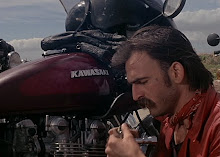During the De Tomaso years, though, a number of inline fours were produced with the Guzzi name on the tank. Guzzi shared De Tomaso ownership with Benelli during the 70s. To confront the Japanese superbike onslaught, Benelli copied a Honda 500 four and added two more cylinders, creating the six-cylinder Sei. Smaller versions of the Sei with four cylinders were produced, badged as the Quattro. Due to the hard work of the Badge Engineering Department at De Tomaso, versions of the Benelli fours rolled out of the plant with Moto Guzzi badging on them.
While the 400 and 500 Quattros were fairly middle of the road by the day's standards, one particular model stood out: the 250 four.
Benelli took their 500 four, stuck it in the copy machine and hit the reduce button a few times. Then, they wrapped it in weird styling where the seat continued up on the gas tank. The gauges were also built into the gas tank. What a busy place, that tank. Benelli versions were sold as the 250 Quattro and Moto Guzzi versions were sold as the 254, a reference to the size of the engine and the number of cylinders.
The little 231cc SOHC four belted out about 30 bhp at a stratospheric 10,500 rpm. Compression was high (11:1), the carbs were tiny (18mm) and the price was enormous. It cost as much or more than many 350cc-class bikes and was quite a bit more than its 250cc-class rivals.
Aside from the frantic engine, the rest of the bike was fairly normal. It had a steel frame, twin shocks and skinny tires. Stopping this screamer was a tiny front disc and a tinier rear drum. One thing in the technical specs that stands out to me is weight. Even though they used an air-cooled four, the bikes managed to be lighter than many of their competitors using twins or singles.
The Benelli twins had flaws deeper than their outrageous price, though. For one, there was the output of the engine. All the power was at the top of the rev range, and since there wasn't much to start with, you had to rev the nuts of it to go anywhere. Its scant torque, 14 lb/ft, was reached way up at 9,000 rpm. There was also the fact that it had five gears, which meant the ratios were longer and that hurt acceleration. Having six gears would have made it easier to keep it on the boil. Top speed was a mere 93 mph.
As flawed as the Benelli twins were, I can't help but like them. I like their small size, both of the bike itself and the engine, and their unique styling. They really didn't look like anything else at the time. Even though they were produced from 1976 to 1986, I feel they aren't well recognized by the public and the motorcycling community. It doesn't hurt that a small four revving to the moon sounds fantastic.
This is an early version of the 250 Quattro. As you can see, the bodywork was pretty avant garde in some respects, like the gas tank and seat areas, and pretty normal in other areas, like the fenders and wheels.
Here's the nacelle containing the gauges and the ignition switch. While putting them here continues with the styling theme of the bike, it doesn't seem to be very practical. Imagine having to look down at the tank to check your speed or revs. To me, that would have to be very distracting.



No comments:
Post a Comment